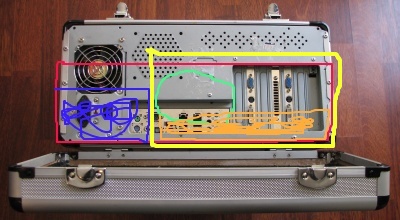The goal of the Mark III is to be a smaller and lighter version version of the Mark II. Below is my original set of goals.
- mATX form factor – Instead of ATX. ATX is 305mm x 244mm (9.6″ x 12″). A little bigger than a piece of paper. mATX is 244mm x 244mm (9.6″ x 9.6″). When I built the Mark II suitable mATX boards were not available. This will save 61mm (3″) from the width.
- Integrated Video – mATX boards with suitable on board video (256 MB) are now available. This will allow me to eliminate the dual video cards which take up space that can be used for other components. I may only be able to drive 1, or maybe 2 monitors instead of 4 that the Mark II can currently handle. It will also be less powerful as the Mark II can join its dual video cards to act as one using Crossfire.
- Core Duo 2 – Now that the Core Duo 2’s are readily available I can use it instead of a Pentium 960. The E6700 roughly is a performance equivalent of the Pentium 960. It however consumes a fraction of the power that the Pentium 960 does. This will allow me to use a lower profile cooler, and a smaller lighter power supply. The high wattage power supply and the processor cooler are major contributors to the current weight.
- Quad Core – Will upgrade to Quad Core when prices fall.
- DVD-RW – Inclusion of a slimline DVD-RW instead of relying on an external one.
- Others – I find that I rarely use the second ethernet port, modem, or the WiFi. If these are not available in a suitable mATX board I can supplement such extras with tiny USB devices.
I hope to reduce the weight from 8 kg (18 pounds) to 5 kg (11.5 pounds). This will make it even more light and much faster than many of the “power laptops”. Laptop Comparison
Retaining Dual Video
While the Mark II can power 4 monitors, I have never needed to. I would like to be able to power 2 monitors. If I cannot, I can use my notebook as a “slave” for debugging, and other types of things that I normally use a second monitor for. However since the second monitor usually is not demanding graphics, I do not need a powerful graphics card. I have seen several half height 128 MB fanless video cards that I might be able to fit without increasing the form factor. This would provide a moderately powerful video card for the second monitor. There are also USB solutions etc, but I would really like to avoid that mess.
How?
An mATX board is smaller. The pink line shows roughly the mATX footprint. Also without the need to reserve so much space for the video cards or their fans a lot of vertical space is freed up for other components (green area). The Core Duo 2 processors require much less power and a smaller lighter power supply can be used. Finally a much smaller processor cooler can be used, possibly a top venting model which could possibly vent directly out of the case. All of this will need to be tested and new air flow studies performed of course.

At a maximum the new size would be the green out line, but optimally I hope to reach the size of the pink outline.

From the back I have shown two possible profiles. A long one using the pink outline, and another more square yellow outline. I will begin experimenting with mock ups soon. When building the Mark II case I also obtained dead motherboards and used them for mount testing. I am obtaining more dead parts to experiment with for the Mark III. The orange area is the footprint of an mATX board with no cards installed. Since video and other features I need I will have integrated on the motherboard I will rely on USB, Firewire, and e-SATA for expansion which leaves more vertical room. The green outline is for the CPU and cooler. The blue area is for power supply. Because of less vertical space requires and more horizontal, it makes more sense to mount it sideways. Now that the power supply requirements are also much lower (roughly 275 watts instead of 430) it will be lighter, but I hope to also obtain a smaller form factor power supply. However I need to make sure it is a quality supply. Most lightweight supplies are light because they are cheap and skimp or eliminate filters, regulators and other parts.

